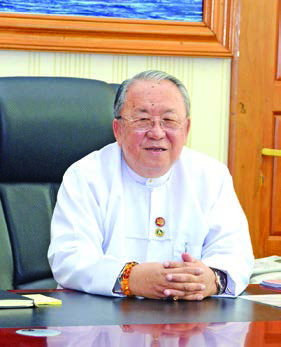By: KK Photo: Aye
Than The Central Bank of Myanmar’s Governor U Kyaw Kyaw Maung talked about the progress of the Central Bank of Myanmar in the third year of the incumbent government.
Q: Can you tell us about Central Bank of Myanmar’s progress during this past year?
A: The Central Bank of Myanmar became a separate entity under the new constitution in 2013. Our main goal are for Myanmar to achieve Monetary Stability, Financial System Stability and Payment and Settlement System Development.
Q: What are some steps the Central Bank of Myanmar has taken towards foreign exchange stability?
A: There are 3 national banks, 19 private banks and 13 foreign banks and their branches that are authorized to sell/buy foreign currency. You can open accounts in Dollars, Euro, Singapore Dollars as well as a Letter of Credit. Two more currencies (Japanese Yen and Chinese Yuan) are available for Letter of Credit as well. In Money Exchange Counters, you can exchange Thai Baht and Malaysian Ringgit in additional to USD, SGD, EUR.

Q: What were some reasons for mandating purchases to only be in MMK?
A: This is to help stabilize our Kyat. There has been illegal trading of foreign currency which often drives the prices of the USD up. We are also trying to draft a new Foreign Currency Management Law where Monetary and Local Gold is clearly defined. The Central Bank also collaborates with the relevant ministries to make sure that export proceeds come back into Myanmar.

Q: What about the current situation with the development of the financial system in Myanmar?
A: The Central Bank of Myanmar is focusing on development of banks in Myanmar since 2013. Currently, there are 27 private banks with 1800 branches, 13 foreign bank branches with 44 representative offices.
The Central Bank is also considering subsidiaries to be able to operate in Myanmar. The biggest accomplishment so far has been regarding financial technology as Internet Banking, Mobile Banking and Mobile Financial Services have improved. For areas that are hard to reach for physical banks, the Financial Technical Services Providers are providing Mobile Banking Services so people in rural areas can have access to a financial service. For NonBank Financial Intermediaries, Money Changers and Mobile Network Operators, it is crucial for them to follow the necessary procedures and reporting deadlines to the Central Bank ofMyanmar.

Can you tell us about development of monetary organizations in Myanmar? Almost 90 notifications for the Central Bank were announced from 2013 to date in order to improve our systems up to international standards.

The foreign banks and its branches do follow these rules and procedures. We also released 5 directives for bank executives and auditors on 25th March 2019: Directive on Fit and Proper Criteria, Directive on Directors of Bank. Directive on External Auditors of Banks, Relative Parties Directive and Directive on Acquisition of Substantial Interest. Our on-site examinations, off-site examinations and risk-based supervision are also practiced as per international standards.

Q: What about other banking systems and accountability of those?
A: The National Payment and Settlement Governing Committee was formed 3 Jan 2019. We are also teaming up with JICA to establish the Central Bank of Myanmar Financial Network System (CENTRAL BANK OF MYANMAR - Net). Credit cards, debit card and prepaid cards are widely used here as well. Additionally, we are standardizing QR codes and is conducting a three-month pilot project through WeChat in Mandalay International Airport. The Quarterly Financial Statistics Bulletin is published every 3 months by the Central Bank of Myanmar along with the Monetary Policy Report. These reports can be viewed on the public website of the Central Bank of Myanmar.

Q: Any other collaborations with other international institutions?
A: The Central Bank of Myanmar is collaborating with IMF, ADB and World Bank as well as the regional South East Asian Central Banks (SEACEN) Research and Training Centre. We receive technical as well as organizational structure consultation from them. There are IMF representatives along with internal auditors, bank supervisors and IMF long term advisors that provides feedback, expertise, training and other discussions for the banks here as well. The Central Bank of Myanmar is also part of the regional network with Cambodia, Thailand, Laos, Singapore and Vietnam in sharing expertise and technology for development of our banks.

Q: For the last question, can you explain to us about the Monetary policy of Myanmar?
A: The institution has adopted the Reserve Money Targeting M o n e t a r y Po l i c y Framework to establish a certain amount of reserve money according to our economy. To achieve our Targeted Reserve Money amount, we are applying the monetary policy instruments such as interest rates, minimum reserve requirements for banks and an open market operations. These have been implemented with the help of IMF as well. (Translated by Myat Thu)



